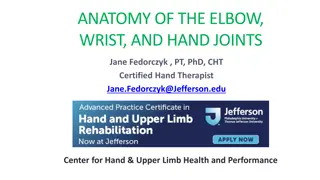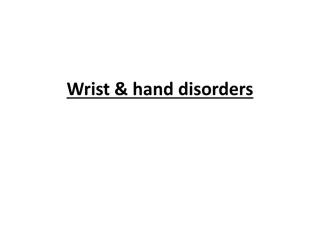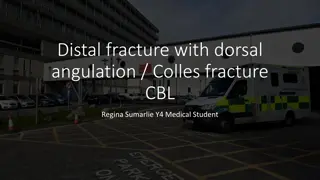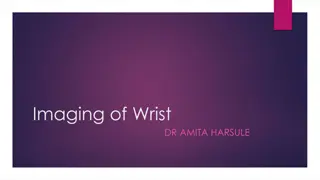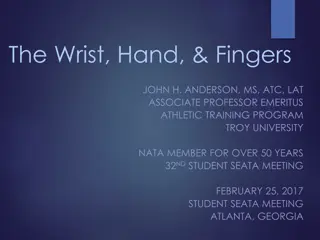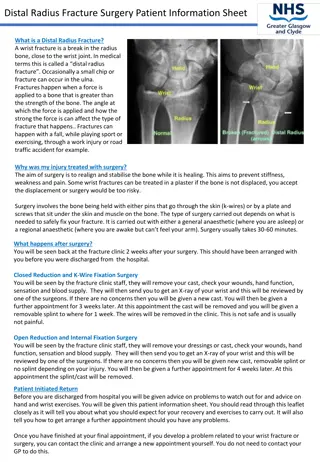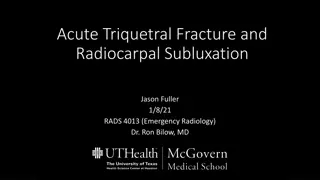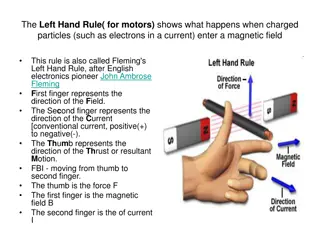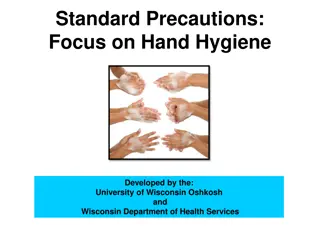Understanding the Anatomy of the Hand and Wrist
Explore the intricate anatomy of the hand and wrist, including structures like the flexor and extensor retinaculae, carpal tunnel, and palmar aponeurosis. Learn about the functions and attachments of these vital components to enhance your knowledge of hand and wrist anatomy.
Uploaded on Sep 10, 2024 | 0 Views
Download Presentation

Please find below an Image/Link to download the presentation.
The content on the website is provided AS IS for your information and personal use only. It may not be sold, licensed, or shared on other websites without obtaining consent from the author. Download presentation by click this link. If you encounter any issues during the download, it is possible that the publisher has removed the file from their server.
E N D
Presentation Transcript
HAND & WRIST Dr. Saeed Vohra Dr. Jamila El-Medany
OBJECTIVES At the end of the lecture, students should be able to: Describe the anatomy of the deep fascia of the wrist & hand (flexor & extensor retinaculae & palmar aponeurosis). List the structures passing superficial & deep to flexor retinaculum. Describe the anatomy of the insertion of long flexor & extensor tendons. Describe the anatomy of the small muscles of the hand (origin, insertion action & nerve supply)
Retinacula Flexor & Extensor Retinaculua: Bands of Deep Fascia at the Wrist Function: Hold the long flexor and extensor tendons at the wrist in position. Attachments: Medially: Both retinacula attached toPisiform & Hook of Hamate. Laterally: Flexor Retinaculum attached to Tubercle of Scaphoid & Trapezium. Extensor Retinaculum attached to Distal end of Radius
Structures Superficial to Flexor Retinaculum From Medial to Lateral 1. Tendon of Flexor carpi ulnaris. 2. Ulnar nerve. 3. Ulnar artery. 4. Palmar cutaneous branch of ulnar nerve. 5. Palmaris longus tendon. 6. Palmar cutaneous branch of median nerve.
Carpal Tunnel Formed from Concave anterior surface of the Carpus covered by Flexor Retinaculum Contents From Medial to Lateral Tendons of flexor digitorum superficialis & profundus Median nerve Flexor Pollicis Longus (Flexor carpi radialis)
Carpal Tunnel Syndrome Causes : Compression of the median nerve within the carpal tunnel Manifestations: 1. Burning pain (pins and needles ) in the lateral three and half fingers. No paresthesia over the thenar eminence?
Carpal Tunnel Syndrome N 2. Weakness or atrophy of the thenar muscles (Ape Hand). Inability to Oppose the thumb.
Palmar Aponeurosis The Thickened deep fascia of the Palm. It is Triangular in shape , occupies the central area of the palm. Apex: Attached to the distal border of flexor retinaculum and receives the insertion of palmaris longus tendon. Base: Divides at the bases of the fingers into four slips that pass into the fingers. Functions: 1. Firmly attached to the overlying skin and improves the grip. 2. Protects the underlying tendons, vessels & nerves. 3. Gives origin to palmaris brevis muscle.
Palmaris Brevis Inserti on Origin NS Action FR and PA. Skin of Palm UN (Superfici al). Branch Corrugation of skin to improve grip
Hypothenar Eminence (3) Origin NS Action Inserti on Ab Dig Min Abduction Pisifor m Base of Prox ph All by Deep branc h of Ulnar FR Flexion With AB DIG MIN Flx Dig Min Pulls the 5th metacarp al forward (Cup the palm) Palmar surface of 5th metacar pal Opp Dig Min
Thenar Eminence (3) Origin NS ACT Insertio n Ab Poll B FR (Base of Prox ph) All from Media n N AB Scaphd& Trapez Flex Poll B Opp Poll FR With AB Poll B FLX FR Opp Lateral part of 1ST Met
Adductor Pollicis Origin Insertion Action NS Oblique Head: Ant. bases of 2nd &3rd meta Trans H: 3rd meta Medial side of base of prox.ph of thumb Deep branch of Ulnar Add
Insertion of Flexor Dig Superficialis & Profundus Flexor dig superficialis Each tendon: Divides into two halves & pass around the Profundus Tendon. The two halves Meet on the posterior aspect of Profundus tendon (partial decussation of fibers). Reunion of the two halves. Further Division into two slips attached to the Borders of Middle Phalanx. Flexor dig Profundus Inserted into the Base of the Distal Phalanx.
Fibrous Flexor (Digital) Sheath A Strong Fibrous Sheath, which covers the anterior surface of the fingers and attached to the sides of the phalanges. Its Proximal end is opened Its Distal end is closed The Sheath with the anterior surfaces of the phalanges & the interphalangeal joints form an Osteofibrous blind Tunnel for the long flexor tendons of the fingers.
Synovial Flexor Sheaths Common Synovial sheath (Ulnar Bursa) Contains tendons of Flexor Digitorum Superficialis & Profundus The Medial part of the sheath extends distally (without interruption) on the tendons of the little finger. The Lateral part of the sheath stops on the middle of the palm. The distal ends of the long flexor tendons to(Index, Middle & Ring) fingers acquire Digital Synovila Sheaths.
Synovial Flexor Sheaths Flexor Pollicis Longus tendon has its own synovial sheath (Radial Bursa) Function of Synovial Sheaths: They allow the long tendons to move smoothly with a minimum of friction beneath the flexor retinaculum and the fibrous flexor sheaths.
Lumbrical Muscles (4) Insertion Origin NS 1ST & 2ND (Lateral two) : Median N. 3RD & 4TH : Ulnar N (Deep branch) Tendons of Flex.dig. profundus EXT. EXP of medial four fingers Action: Flex metacarpophalangeal joints and extend interphalangeal joints of fingers Except thumb
Palmar Interossei (4) NS Origin Insertion 1st: Base of 1st metacarpal. Other three: Ant. Surface of Shafts of 2nd , 4rd & 5th metacarpals. Proximal phalanges of thumb ,index, ring, & little fingers and Extensor expansion Un: deep Branch 2 3 4 1 2 3 4 Action: Adduction of fingers toward center of the 3rd one.
Dorsal Interossei (4) AB Origin Insertion NS AB Contiguous sides of shafts of Metacarpals Proximal Phalang of index, ring ,mid finger & EX Un deep Branch 3 2 4 1 Action: Abduction of fingers away from the 3rd one.
Action of Lumbricals & Interossei Writing position
Extensor Expansion Formed from the expansion of the tendons of extensor dig. at the PIJ, The tendon splits into three parts: One Central: inserted into the base of Middle phalanx. Two laterals: inserted into the base of the Distal phalanx. The Expansion Receives the insertions of: Corresponding Interosseous muscle (on each side). Lumbrical muscle (on the lateral side).




